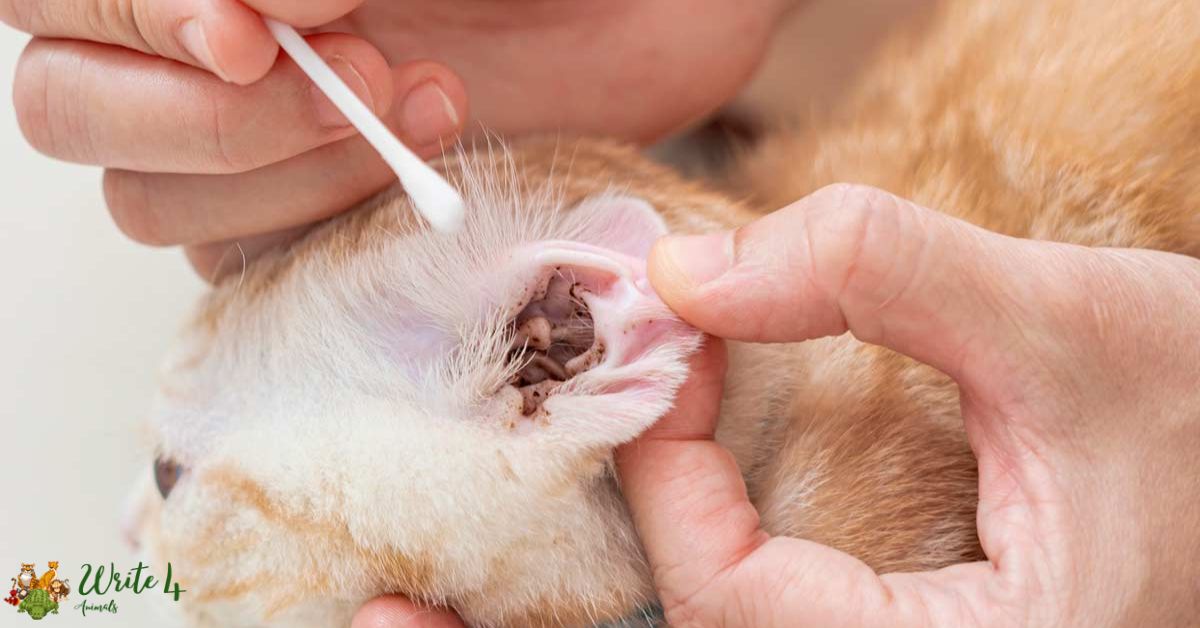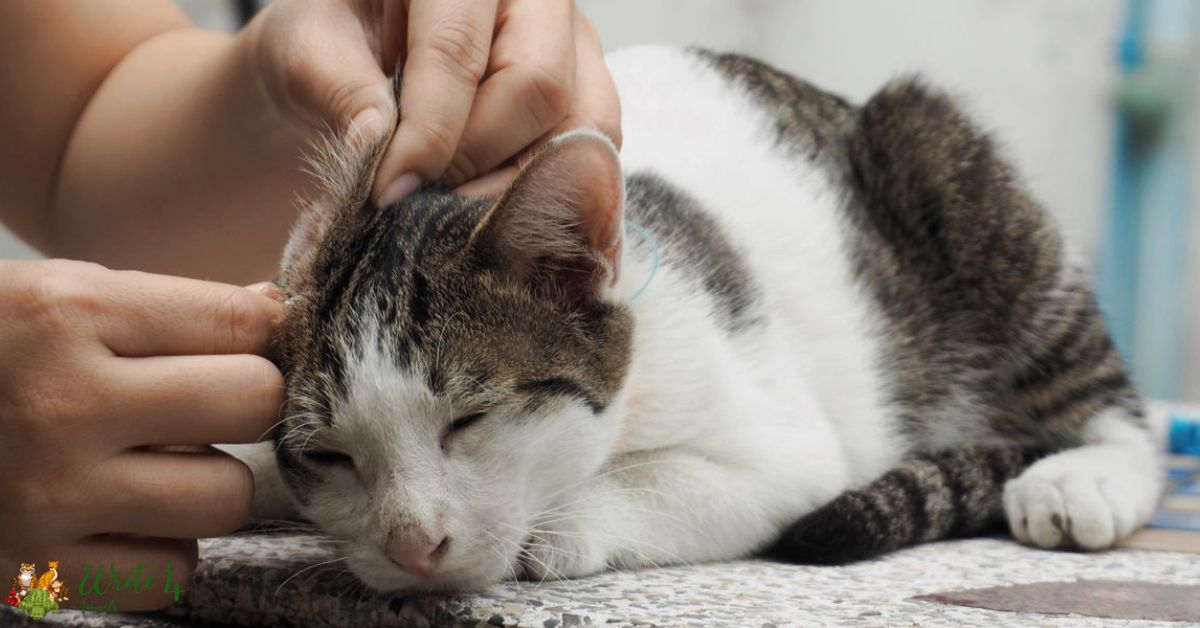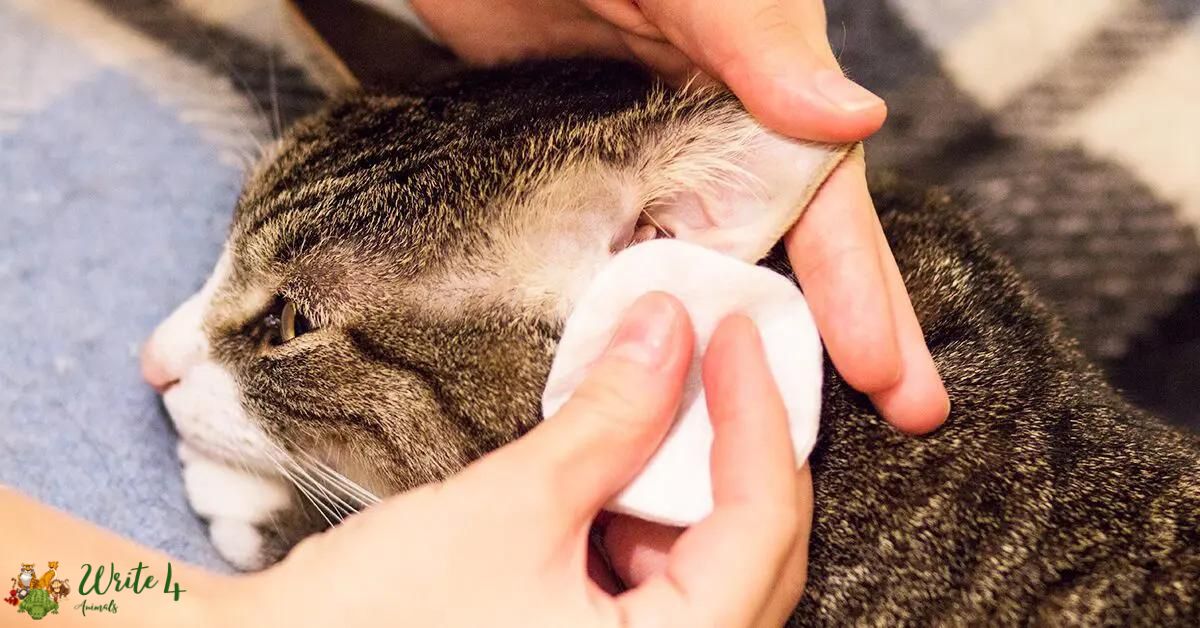As cat owners, we strive to provide the best care for our feline companions, ensuring their health and well-being. One common issue that can raise concerns is the presence of black gunk in a cat’s ears. While mites are often the first culprit that comes to mind, there are various other factors that can contribute to this unsettling phenomenon. In this comprehensive guide, we will delve into the causes, symptoms, treatment, and prevention of the black gunk in your cat’s ears that isn’t caused by mites.
Identifying the Culprit: What Is the Black Gunk?
When you discover black gunk in your cat’s ears, it’s natural to wonder about its origin. This section delves into unraveling the mystery behind the substance that’s caught your attention. By understanding what the black gunk is, you’ll be better equipped to address the issue effectively. We explore the potential causes, ranging from infections to allergies, and provide insights into why it might occur.
Characteristics of the Substance: Describing the appearance and texture of the black gunk
The appearance and texture of the black gunk can vary, but it’s often a dark, sticky, and sometimes crusty material. While it’s unsettling to discover, understanding its consistency and color can offer valuable clues about its source. Detailed description helps you communicate with your veterinarian, aiding in accurate diagnosis and appropriate treatment. By examining these characteristics closely, you’ll gain a clearer picture of what might be causing the black gunk in your cat’s ears.
Distinguishing from Other Substances: Differentiating the gunk from earwax, dirt, and mites
Distinguishing the black gunk from other substances is a crucial step in addressing your cat’s ear health. Earwax, dirt, and mites are often confused with the black residue, but they have distinct characteristics. We guide you through the process of identifying these substances, providing guidance on how to tell them apart from the black gunk. Accurate differentiation is pivotal for effective treatment, ensuring that your cat receives the appropriate care based on the specific issue at hand.
Common Misconceptions about Black Gunk
Misunderstandings about the black gunk can lead to confusion and unnecessary worry. This section aims to clear up some of the common misconceptions associated with the substance and provide accurate information to help you make informed decisions about your cat’s ear health.
Mistaking It for Earwax: Exploring why people might confuse the gunk with normal earwax
Mistaking the black gunk for regular earwax is a common misconception. We delve into the reasons behind this confusion, addressing factors such as appearance and texture. Understanding why this misconception arises helps you approach the issue with a well-informed perspective. By learning to differentiate between the two, you can ensure that you’re providing the right care for your cat’s ears.
Addressing Mite Misconceptions: Debunking the myth that all black gunk is caused by mites
While mites are a known cause of ear issues in cats, it’s incorrect to assume that all instances of black gunk are due to mites. This section debunks the myth and provides insights into the range of factors that can lead to the dark residue. By addressing this misconception, we empower you to approach the situation with a comprehensive understanding, guiding you toward the proper steps for diagnosis and treatment.
Potential Causes of Black Gunk in Cat’s Ears
Cat owners often encounter the perplexing issue of black gunk in their feline companion’s ears. This section delves into the potential culprits behind this phenomenon, shedding light on various factors beyond the surface.

Ear Mites: Ear mites are microscopic parasites that can infest a cat’s ear canal, leading to itching, inflammation, and the production of dark discharge. We will provide an in-depth explanation of ear mites, their life cycle, common symptoms, and their connection to the black substance.
Bacterial or Yeast Infections: Bacterial or yeast infections in the ears can create a conducive environment for the buildup of dark material. This segment will explore how these infections develop, their impact on the ear’s health, and their role in causing the troubling gunk.
Allergies and Environmental Factors: Allergies, whether food-related or triggered by environmental factors, can lead to inflammation and increased wax production. This part will examine how allergies contribute to the accumulation of black residue and ways to identify potential allergens.
Recognizing the Signs: How to Tell If It’s a Problem
Identifying whether the black gunk is a cause for concern requires careful observation of your cat’s behavior and habits. This section focuses on key indicators that can help determine whether the issue is a problem that necessitates professional attention.
Behavioral Changes: Cats often display subtle behavioral shifts when they are experiencing discomfort. We will discuss how changes in activity levels, interactions, or appetite might indicate an underlying problem.
Scratching and Discomfort: Excessive scratching, head shaking, and tilting are behaviors that warrant attention. We will delve into how these actions can signify irritation or pain in the ears and the importance of addressing these signs promptly.
Understanding the potential causes and recognizing the signs associated with the black gunk in your cat’s ears empowers you as a responsible pet owner. By delving into these aspects, you can take informed steps toward ensuring your feline friend’s ear health and overall well-being.
Diagnosis and Professional Guidance
When confronted with the issue of black gunk in your cat’s ears, seeking a veterinarian’s expertise is paramount. An accurate diagnosis is crucial to ensure the appropriate course of action. A veterinary examination is essential to determine the underlying cause of the black discharge. The vet will thoroughly inspect your cat’s ears, looking for signs of infections, inflammation, or the presence of foreign objects.
In some cases, tests and samples may be required to obtain a comprehensive understanding of the issue. This could involve swabbing the ear to collect samples for laboratory analysis. These tests help identify the specific pathogen responsible for the problem, whether it’s bacteria, yeast, or another factor.
By emphasizing the significance of a veterinary evaluation, you ensure that your cat receives the care it needs. A professional assessment is the foundation for effective treatment and the restoration of your cat’s ear health.
Video Credit – Cats
Treatment Options
Addressing the issue of black ear discharge involves a range of treatment options designed to tackle the underlying cause. Medicated ear drops are a common approach to alleviating the problem. These drops often contain ingredients that combat infections or fungal overgrowth. Your veterinarian will prescribe the appropriate medication based on the diagnosis.
In cases of bacterial or fungal infections, antibiotics and antifungal treatments may be necessary. These medications target the pathogens responsible for the issue, promoting healing and reducing discomfort.
Additionally, proper cleaning techniques play a crucial role in resolving the problem. Your vet can guide you on safe and effective methods for cleaning your cat’s ears. It’s important to follow their recommendations to prevent further irritation or complications.
Home Care and Prevention
Maintaining your cat’s ear health is a proactive way to prevent the occurrence of black gunk. Regular cleaning should be a part of your routine, but it’s crucial to do it correctly. Consult your veterinarian for guidance on safe and effective ear cleaning techniques. Avoid using cotton swabs, as they can push debris further into the ear canal.
Additionally, exploring your cat’s diet and nutrition can contribute to better ear health. Certain nutrients, like Omega-3 fatty acids, are known to have anti-inflammatory properties that can help prevent ear issues. Discuss your cat’s diet with your vet to ensure it supports their overall well-being, including ear health.
Case Studies and Real-Life Experiences
Personal stories from fellow cat owners who have faced black gunk issues in their feline companions can provide valuable insights. These anecdotes can shed light on different scenarios, symptoms, and approaches to handling the situation. Sharing these experiences can create a sense of community and provide comfort to those dealing with similar challenges.

From these real-life experiences, lessons can be learned. Extracting key takeaways such as early detection, prompt veterinary care, and maintaining regular ear hygiene can help others navigate similar situations more effectively.
When to Seek Immediate Veterinary Care
Knowing when to seek veterinary attention is essential to your cat’s well-being. Severe symptoms such as persistent head tilting, shaking, disorientation, or excessive scratching should not be ignored. These signs might indicate a more serious issue that requires immediate attention.
Neglecting to address ear problems can lead to potential complications. Left untreated, infections can spread, causing discomfort and affecting your cat’s quality of life. Prompt veterinary care ensures accurate diagnosis and timely treatment, preventing the escalation of issues and maintaining your cat’s ear health.
Long-Term Management Strategies
Maintaining your cat’s ear health requires a proactive approach beyond initial treatment. Follow-up visits to your veterinarian play a crucial role in ensuring the ongoing management of black ear gunk. Regular check-ups allow your vet to monitor progress, address any changes, and make adjustments to the treatment plan as needed. These visits also provide opportunities for early detection of potential issues, helping to prevent the recurrence of the problem.
Preventive measures are equally essential in long-term management. Detailing steps to prevent the buildup of gunk in your cat’s ears can significantly contribute to their overall ear health. Proper ear hygiene, using veterinarian-approved cleaning solutions, and avoiding excessive moisture can all play a part in keeping your cat’s ears clean and free from problems.
Natural and Holistic Approaches
In addition to conventional treatments, exploring natural and holistic approaches can provide valuable complements to your cat’s care regimen. Herbal remedies offer alternative options that may support your cat’s ear health. Certain herbs, like calendula and chamomile, are known for their soothing properties and may help alleviate discomfort.
Holistic care goes beyond just treating the symptoms. It involves addressing your cat’s overall health and well-being. Discussing holistic approaches, such as stress reduction techniques, balanced nutrition, and environmental enrichment, can contribute to preventing future ear issues and promoting a healthier, happier feline friend.
Summary of Key Points
In summary, understanding the causes, symptoms, and treatment options for black ear gunk in cats is essential for their well-being. By delving into the various factors contributing to the issue, you empower yourself to take informed action. Proper diagnosis by a veterinarian is fundamental, allowing you to tailor the treatment plan to your cat’s specific needs.
Follow-up visits ensure that your cat’s progress is monitored and any necessary adjustments are made. Preventive measures serve as a foundation for ongoing ear health management. Incorporating natural and holistic approaches can enhance your cat’s overall quality of life and help maintain ear health in the long run.
Recapping these key points reinforces the importance of early intervention, proper care, and ongoing vigilance when it comes to your cat’s ear health. By providing the best possible care, you ensure that your feline companion enjoys a comfortable and thriving life.
Conclusion
In conclusion, understanding and addressing the black gunk issue in your cat’s ears goes a long way in maintaining their overall well-being. By being vigilant and seeking veterinary guidance, you empower yourself as a responsible cat owner. Remember that early intervention and proper care can make a significant difference in your feline friend’s comfort and health.
As you navigate the world of cat ear health, approach it with a hopeful outlook, knowing that with the right care, your beloved companion can enjoy a happier and healthier life.
Frequently Asked Questions
[sc_fs_multi_faq headline-0=”h4″ question-0=”What could be causing the black gunk in my cat’s ears if it’s not mites?” answer-0=”While mites are a common culprit, there are several other potential causes for the black gunk in your cat’s ears. These may include bacterial or yeast infections, excessive ear wax production, allergies, or even foreign objects lodged in the ear canal.” image-0=”” headline-1=”h4″ question-1=”How can I tell if my cat has an infection or if it’s just wax buildup?” answer-1=”Differentiating between an infection and wax buildup can be challenging, as both can lead to dark ear discharge. Look for signs such as excessive scratching, head tilting, shaking, or a strong odor. Consulting a veterinarian is crucial for an accurate diagnosis through professional examination and possibly lab tests.” image-1=”” headline-2=”h4″ question-2=”Can allergies really cause black ear gunk in cats?” answer-2=”Yes, allergies can contribute to black ear residue in cats. Allergic reactions can lead to inflammation and increased ear wax production, resulting in the buildup of dark material in the ears. Identifying the allergen and seeking veterinary guidance are important steps in addressing this issue.” image-2=”” headline-3=”h4″ question-3=”Is it safe to clean my cat’s ears if I see black discharge?” answer-3=”Cleaning your cat’s ears can be beneficial, but it’s essential to do it correctly and safely. Use a veterinarian-recommended ear cleaning solution and follow their instructions. If you’re unsure or if the discharge persists, consult your vet before attempting any cleaning.” image-3=”” headline-4=”h4″ question-4=”Should I be concerned about foreign objects in my cat’s ears causing the black gunk?” answer-4=”Foreign objects can indeed contribute to dark ear discharge. Cats are curious creatures and might introduce small objects into their ears. Signs of discomfort, head shaking, or tilting can indicate a potential issue. If you suspect a foreign object, seek veterinary attention promptly.” image-4=”” headline-5=”h4″ question-5=”Can I treat my cat’s ear issue at home, or do I need to see a vet?” answer-5=”While some mild cases of ear issues can be managed at home, it’s always best to consult a veterinarian for an accurate diagnosis. Only a professional can determine the root cause and provide appropriate treatment. Home remedies might not address the underlying problem effectively.” image-5=”” headline-6=”h4″ question-6=”Can the black ear discharge be a sign of a more serious health problem?” answer-6=”In some cases, dark ear discharge can indeed signal a more serious health problem, especially if left untreated. Conditions like chronic infections or allergies can lead to complications. Seeking veterinary attention ensures proper diagnosis and early intervention if needed.” image-6=”” headline-7=”h4″ question-7=”Are there any preventive measures I can take to avoid black ear discharge in my cat?” answer-7=”Maintaining regular ear hygiene and cleaning can help prevent excessive buildup. Regular veterinary check-ups also play a role in early detection of any potential issues. Avoid inserting objects into the ear canal and ensure your cat’s environment is free from allergens that could trigger ear problems.” image-7=”” headline-8=”h4″ question-8=”Is black ear residue a common issue in cats, or should I be overly concerned?” answer-8=”Black ear residue is not uncommon in cats and can be caused by various factors. While not every case is cause for alarm, it’s important to address the issue promptly. Consulting a veterinarian provides peace of mind and ensures the health and comfort of your feline companion.” image-8=”” headline-9=”h4″ question-9=”What steps should I take if I suspect my cat has an ear problem involving black gunk?” answer-9=”If you suspect an ear problem, the first step is to consult a veterinarian. Professional examination, accurate diagnosis, and appropriate treatment are essential. Avoid attempting home remedies without veterinary guidance, as they might worsen the issue. Prompt action ensures your cat’s ear health is properly managed.” image-9=”” count=”10″ html=”true” css_class=””]
Recommended
1. Siamese Ragdoll Cat: Ragamese Complete Guide
2. 12 Biggest Cat Breed in the World
